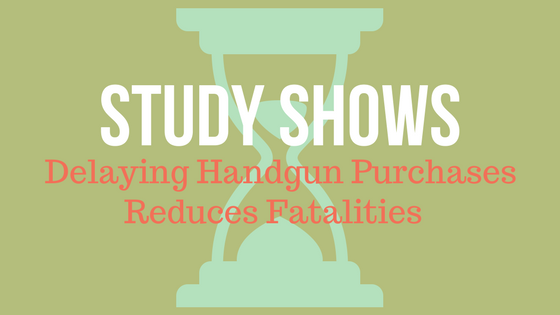It’s no secret that the United States leads the way in gun-related deaths each year. In fact, guns cause more than 33,000 deaths each year. For reference, this is roughly the same number of people who die from car accidents in the United States, but in Japan dying from a gunshot carries the same odds as dying from a lightning strike. Those in Germany are equally likely to die from contact with a thrown or falling object as they are from a gun. In New Zealand, falling from a ladder carries the same odds as dying from a gun.
Why is it that gun-related deaths are so much higher in the United States? One article posits that, quite simply, there are so many more guns. Americans make up only 4.4% of the world’s population, but own a whopping 42% of the world’s guns! Certainly, this is not the only reason for the number of gun-related deaths in the United States, but what if we could reduce gun-related deaths simply by reducing the number of guns? Or, more accurately, increasing the time between when a gun purchase is initiated and when the firearm is handed to the buyer?
written by: Tara Luther, Promega
Why is this an effective strategy? Imposing a waiting period during a handgun purchase allows would-be perpetrators time to “cool off” until they are in a calmer state of mind, or may close the window of opportunity they had to use the weapon.
A 2016 article in PNAS looks at the impact of imposing a waiting period (usually between two and seven days), over the course of 45 years by comparing data on law changes and mortalility at the state level in the United States.
In order to do this, the authors created a panel of every modification in waiting period laws throughout the United States between 1970 – 2014 when 44 states had at least some sort of waiting period at one point, and combined this with annual data on gun-related deaths from the Centers for Disease Control and Prevention.
When looking across the 45 year period, they found that waiting periods are associated with 17% fewer gun-related homicides, and led to a 7-11% reduction in gun suicides per year. The authors then looked at the years 1994-1998, when the Brady Handgun Violence Prevention Act was enforced. The Brady Act was a federal law that required background checks on handgun purchases from licensed firearm dealers and created five day waiting periods to allow sufficient time for the check.
During this time, the authors discovered that the Brady years resulted in 17% fewer gun-related homicide deaths and a 6% reduction in gun suicides. This equates to about 39 fewer homicides per state and 17 fewer suicides per state each year. The authors also noted that non-gun homicide rates didn’t increase during this time, showing that would-be perpetrators did not simply find a different method of carrying out their crime.
Currently, there are 17 states have with imposed handgun waiting periods, and if the numbers were to hold true at 17% fewer gun-related homicides per year, this would equate to approximately 750 fewer deaths. The authors reason that by expanding these laws to the entire United States would mean gun-related deaths would fall by an additional 910 people without imposing restrictions on who could own a gun.
WOULD YOU LIKE TO SEE MORE ARTICLES LIKE THIS? SUBSCRIBE TO THE ISHI BLOG BELOW!
SUBSCRIBE NOW!


